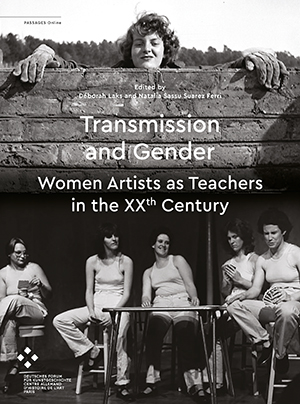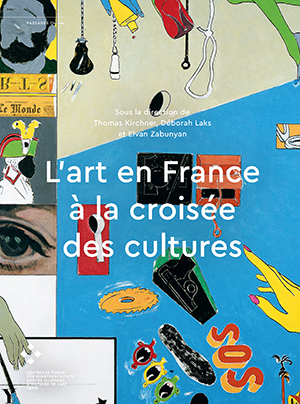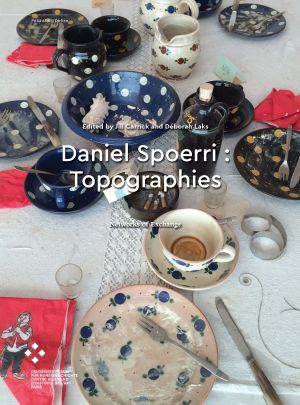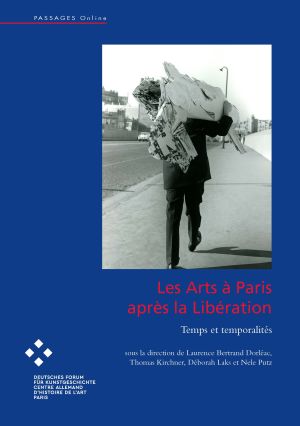Laks, Déborah
Transmission and Gender: Women Artists as Teachers in the XXth Century
While the field of art education is slowly but surely feminizing, the specificity of women's trajectories and their effects on transmission and creation are at the crossroads of several fields and open up a plurality of questions. What does a woman's career look like, how are institutions modified by the arrival of women? How are hierarchies rethought, is the field of reference of students evolving, what do the new methods developed allow? The articles gathered in this volume highlight individual trajectories and broader debates taking place in art schools, all tracing the evolutions that the teaching by women artists reveals, prepares or accomplishes in the field of contemporary creation.
Tandis que le champ de l’enseignement de l’art se féminise, lentement mais sûrement, la spécificité des trajectoires féminines et de leurs effets sur la transmission et la création se trouvent au carrefour de plusieurs champs et ouvrent une pluralité de questionnements. A quoi ressemble une carrière féminine, de quelle manière les institutions sont-elles modifiées par l’arrivée des femmes ? Comment les hiérarchies sont-elles repensées, le champ référentiel des élèves évolue-t-il, que permettent les nouvelles méthodes développées ? Les articles réunis mettent en lumière des trajectoires individuelles tout en retraçant plus largement les luttes dont les écoles sont le théâtre et les évolutions que l’enseignement par des artistes femmes révèle, prépare ou accomplit dans le champ de la création contemporaine.
L’art en France à la croisée des cultures
This book collects the reflections and discussions generated at the DFK Paris in the context of the annual theme 2016/17 “Art in France in a Transcultural Context”. The intense exchange between this year’s researchers expanded beyond their individual projects and questioned Eurocentrism, analyzed specific forms of hegemony and demonstrated the consequences of colonial history. By exploring different case studies in African, American, Asian, European, and Oceanian contexts, it could be shown how artistic and intellectual creation and engagement inscribe themselves into the mobilities of globalism. Reflecting on the interdependencies between the repositionings described and art history, the need to acknowledge in art historical analysis the cross-paths, the disorientations, the fragmentary, and the uprooted – here and now, here and elsewhere – becomes clear.
Cet ouvrage rassemble la somme des réflexions et discussions menée au DFK Paris dans le cadre du sujet annuel de 2016/17 « Les arts en France à la croisée des cultures ». Avec leur échange intensif, les chercheurs ont pu renforcer le questionnement de l’eurocentrisme ainsi que démontrer et analyser les différentes formes de l’hégémonie et les conséquences des histoires coloniales. En examinant des différentes études de cas dans les contextes africains, américains, asiatiques, européens et océaniens, il devient évident que la création et l’engagement artistiques et intellectuels appartiennent aux mobilités de la mondialité. Mettant en avant les interdépendances entre les repositionnements décrits et l'histoire de l'art, on comprend la nécessité de reconnaître dans l'analyse en histoire de l'art les chemins de traverse, les désorientations, le fragmentaire et les déracinements - ici et maintenant, ici et ailleurs.
Daniel Spoerri : Topographies: Networks of Exchange
Daniel Spoerri's oeuvre occupies the intersection of several artistic trends and tendencies. Most commentators on his work, on the other hand, considered him a New Realist artist, and his work is often reduced to that of the trap paintings. This abbreviation, consolidated by art historiography and largely formed by the classificatory efforts of Pierre Restany, corresponds, however, to only a small part of his oeuvre. Spoerri's films, his poetry, his books, the MAT editions, his importance as an organiser of events and exhibitions are examples of the diversity and openness of his activities. In the 1960s he was close to Fluxus and Zero and laid the foundation for Eat Art. Understanding the artist's work as part of transnational networks that combine different disciplines and theoretical and material approaches suggests a re-evaluation of Spoerri's interactions with a wide range of contemporary actors. This book explores these questions as the proceedings of the colloquium "Topographies of Daniel Spoerri: the artist in his networks" organised by Jill Carrick and Déborah Laks at DFK Paris on 22 and 23 October 2018.
Le travail de Daniel Spoerri se situe au croisement de plusieurs courants et tendances artistiques. Pour la plupart des commentateurs, il est pourtant généralement abordé comme un artiste du Nouveau Réalisme, et son œuvre antonnée au Tableau-Piège. Cette place délimitée, forgée par une historiographie largement marquée par les efforts classificateurs de Pierre Restany, ne correspond en réalité qu’à une petite partie de son travail. Ses films, sa poésie, ses livres, les éditions MAT, ses activités d’organisateur d’évènements et d’expositions sont autant d’exemples de la diversité et de l’ouverture de ses champs de recherche. Dans les années 1960, il se rapproche de Fluxus et de Zero et pose les fondements du Eat Art. Son œuvre s’inscrit dans des réseaux transnationaux mêlant des disciplines, des approches théoriques et matérielles différentes, et il importe aujourd’hui de réévaluer ses interactions avec les différents acteurs de la période. Cet ouvrage constitue les actes du colloque « Topographies de Daniel Spoerri : l’artiste en ses réseaux » organisé au DFK Paris par Jill Carrick et Déborah Laks les 22 et 23 octobre 2018.
Les Arts à Paris après la Libération: Temps et Temporalités
The volume sheds new light on the Parisian art world after the Second World War, its protagonists, inter(national) dimensions and aesthetic challenges. It assembles a selection of contributions of the annual congress 2014/15 held at the German Center for Art History Paris as well as further results of research undertaken during that same year. Besides questions of historiography the publication focuses on case studies in which renowned artists like Giacometti, Picasso and Brassaï are analized. Furthermore, new protagonists, institutions and media are introduced and innovative perspectives developed. The volume thus makes a valuable contribution to the reevaluation of art of the postwar period.










